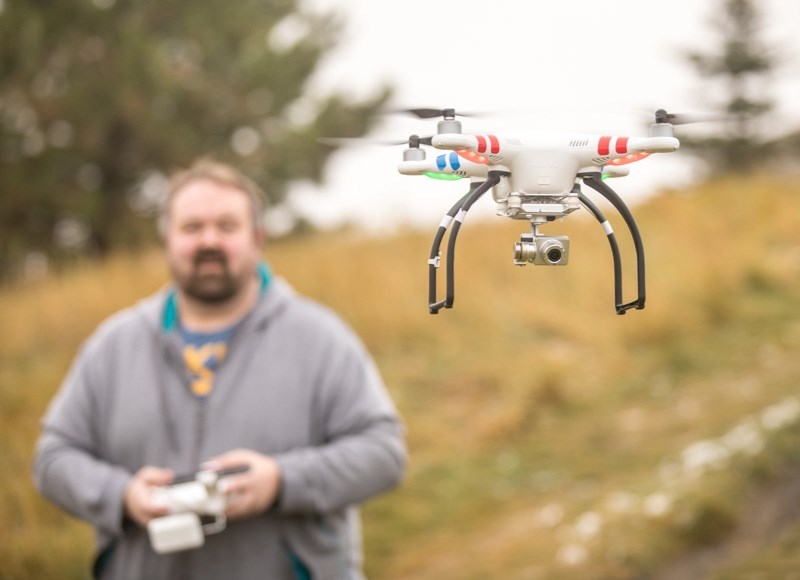More drones flying over the Foothills in recent years have some raising questions about privacy and legal issues.
Heritage Pointe-area resident Rob Neil had a particularly concerning incident early in the morning on Oct. 12. A trail camera in the backyard of his home just off 80 Street showed a drone enter his yard at 6:08 a.m. before retreating out of his yard into the darkness.
“I’ve got a 30-second video and it flies right through the video,” said Neil. “Otherwise, we wouldn’t have even known it was there.”
He alerted all of the neighbours and told them to be mindful of their properties, lock doors and make sure there wasn’t anything of value in their yards. He also reported the incident to the RCMP.
“We kind of figured that it would be somebody that’s watching the houses, looking at who’s getting up in the morning, getting ready,and what time they leave their house,” said Neil. “Then they’d know when people leave the house and it’s pretty much empty.”
He said there was no evidence of the drone operator on video or in the yard.
Flying in the dark, into private property and out of sight of the aircraft operator violates Transport Canada rules for drone activity.
Recreational operators need to get permission from Transport Canada to fly their machines if they weigh more than 35 kilograms. For commercial or research use, permission is required for units weighing more than 25 kg.
There are varying reasons for drone use, both commercial and recreational.
Okotoks resident Bryce Schutte once worked with realtors on their rural listings.
“I used it to take aerial videos for realtors for their acreages for a while,” said Schutte. “But now I just use it for myself. It’s as close to flying as you can get without getting up in a plane.”
He said he likes to take his drone, a Phantom 3, out into wide-open spaces to play around. His machine is under two kilograms, so the only restrictions are to stay away from airports, fly in daylight, always be in sight of the aircraft and respect the privacy of others.
Schutte said he plays by the rules and has never had a confrontation with anyone during one of his flights, though sometimes he does get eyed down.
“The times I’ve gone out in more residential areas, like when I was doing real estate work or sometimes recreationally, I’ve definitely had people looking and kind of wondering what I’m doing, but I’ve never really had anybody confront me,” said Schutte.
MD Coun. Suzanne Oel said concerns surrounding drone use in the MD of Foothills are primarily centered on privacy issues.
“I think the part that’s scary to everybody is that someone’s flying a drone over your place and you don’t want someone to be able to take a look at your private property,” said Oel. “It’s just that whole privacy thing.”
She said with Google Earth and other technological advances, the advent of drones was inevitable and could bring some benefits if people follow the guidelines.
Seeing a machine fly over your property can still be unnerving, she said.
“Automatically you’re thinking spy, or criminal, or whatever,” said Oel. “I think if people are going to use these as tools or for fun they need to make sure they’re respecting people’s property and privacy and asking permission before they enter any land.”
In September, MD council received a written request from an individual asking for permission to fly over municipally owned lands to take aerial photographs for a professional portfolio.
“They want to go on some land that had water features on it, but they went through the complete correct process and they were following it to the letter,” said Oel. “That’s what’s important here.”
She said there are many practical applications for drone use, such as surveying land or counting and tracking wildlife. The municipality has been investigating the possibility of using one for site visits, she said.
Greg Shyba, chief executive officer at Ann and Sandy Cross Conservation Area, said they received government funding to purchase a drone that allowed them to map the 19 springs in the area.
“We used the drone to identify them and also detect the contour of the land,” said Shyba. “It absolutely allowed us to do something we couldn’t have done as accurately.”
It helped to make decisions on tree planting or wetlands projects because the drone allowed them to see the land from 100 to 200 feet, he said.
“It was a great tool for that and an inexpensive tool for sure,” said Shyba.
He said there have been concerns with people flying drones over the Cross Conservation lands without consent.
“There’s a worry people are using them for hunting purposes and things like that,” said Shyba. “We don’t allow hunting on the conservation area, but let’s say hunters know there’s elk down here so they could send in a drone and see where the herd is and even perhaps scare them off the property so that they could bag them.”
Alberta Fish and Wildlife hunting regulations now include a clause specific to drone use, stating it is unlawful to “use any aircraft for the purpose of hunting wildlife, including unmanned aerial vehicles,” or to “communicate, for the purpose of hunting, the whereabouts or signs of wildlife from knowledge gained from a manned or unmanned aircraft flight to anyone at any time during or after the flight.”




